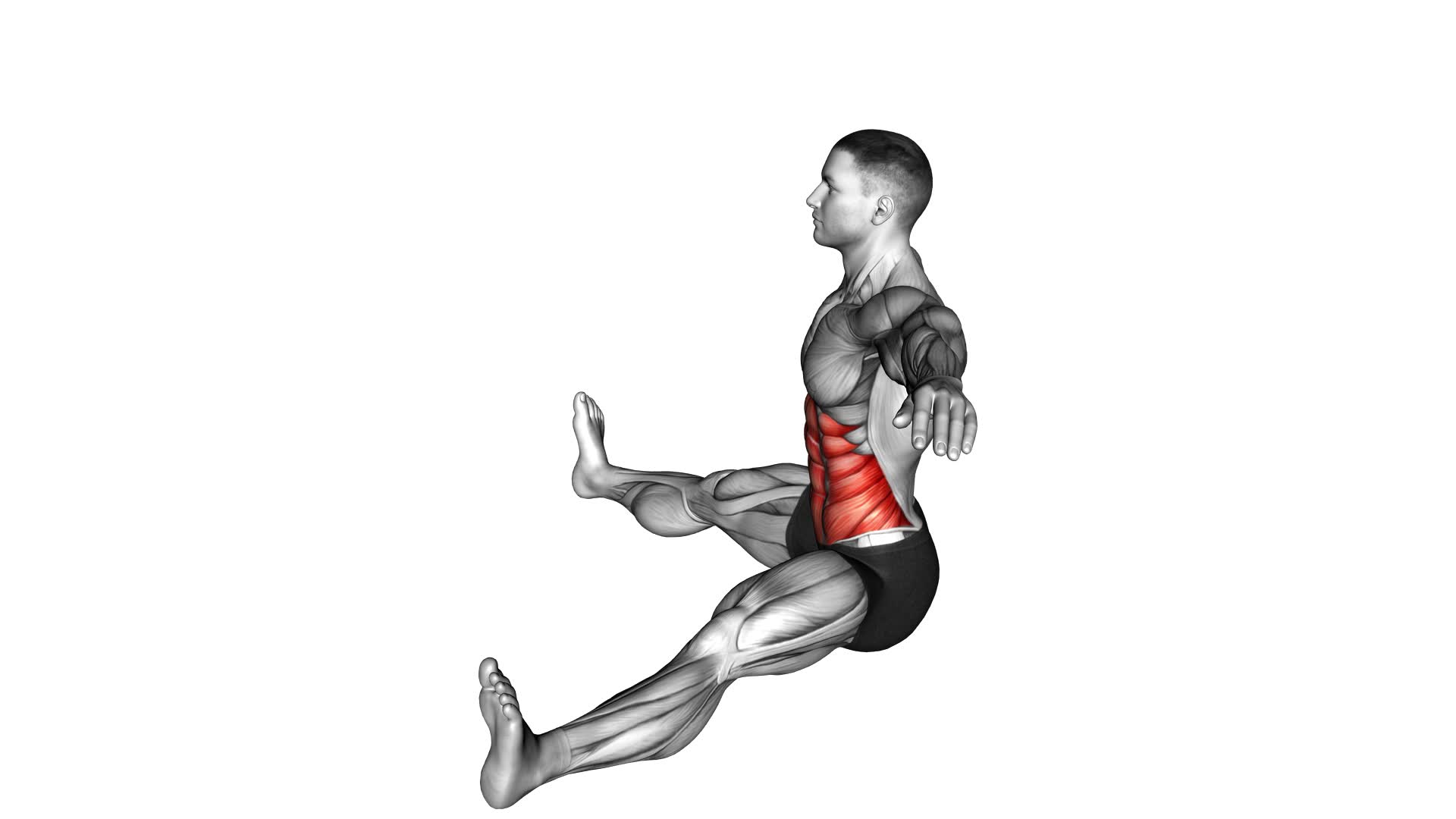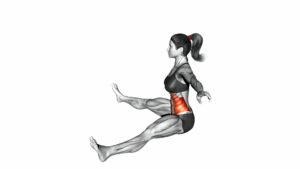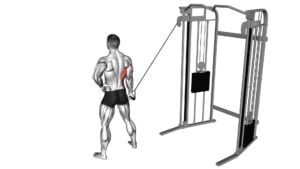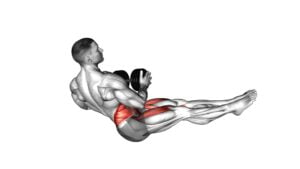Seated Twist (Straight Arm) (male) – Video Exercise Guide & Tips

Get ready to twist your way to a stronger core with the Seated Twist (Straight Arm) exercise.
Watch This Exercise Video
In this video exercise guide, you'll learn the proper technique for this effective move. Avoid common mistakes and discover tips for maximizing its effectiveness.
Whether you're a beginner or looking for a challenge, modifications and progressions are included.
Remember to prioritize safety as you engage your muscles and improve your overall fitness.
Let's get twisting!
Key Takeaways
- Seated Twist (Straight Arm) exercise strengthens the core and engages abdominal muscles, obliques, and lower back muscles.
- This exercise improves spinal mobility by stretching and mobilizing muscles and joints in the spine.
- Seated Twist (Straight Arm) alleviates stiffness, enhances flexibility and range of motion.
- It supports proper posture and develops a strong and stable core, which is crucial for everyday movements and activities.
Benefits of the Seated Twist (Straight Arm) Exercise
What are the benefits of the Seated Twist (Straight Arm) exercise for you?
This exercise offers several advantages that can contribute to your overall fitness and well-being. One of the primary benefits is core strengthening. As you twist your torso, your abdominal muscles, obliques, and lower back muscles are engaged, providing a challenging workout for your core. By regularly incorporating this exercise into your routine, you can develop a strong and stable core, which is essential for maintaining proper posture and supporting your spine.
In addition to core strengthening, the Seated Twist (Straight Arm) exercise also helps improve spinal mobility. As you rotate your torso, you're effectively stretching and mobilizing the muscles and joints in your spine. This can help alleviate stiffness, enhance flexibility, and improve your overall range of motion. By performing this exercise regularly, you can maintain a healthy and mobile spine, which is crucial for everyday movements and activities.
Transitioning into the subsequent section about the proper technique for the seated twist (straight arm), it's important to ensure that you perform this exercise correctly to maximize its benefits and minimize the risk of injury.
Proper Technique for the Seated Twist (Straight Arm)
To perform the Seated Twist (Straight Arm) exercise correctly, sit on a mat with your legs crossed and your back straight. Place your left hand on the mat behind you, with fingers pointing away from your body. Extend your right arm straight up towards the ceiling.
Inhale deeply, and as you exhale, twist your torso to the left, reaching your right arm across your body and towards the left side of the mat. Keep your core engaged throughout the movement, and focus on rotating from your waist rather than just your shoulders. Hold the twist for a few seconds, feeling the stretch in your back and shoulders. Return to the starting position and repeat on the other side.
The Seated Twist (Straight Arm) exercise offers various seated twist variations that can be added to your workout routine. This exercise is particularly beneficial for core strength as it targets the obliques, transverse abdominis, and deep back muscles. By incorporating this exercise into your routine, you can improve your spinal mobility, enhance your posture, and strengthen your core muscles.
Now that you understand the proper technique for the Seated Twist (Straight Arm) exercise, let's explore common mistakes to avoid during this exercise to ensure you maximize its benefits and prevent any potential injuries.
Common Mistakes to Avoid During the Seated Twist (Straight Arm)
When performing the seated twist with straight arms, it's important to maintain proper form to maximize the effectiveness of the exercise and prevent injuries.
One common mistake to avoid is hunching your back or rounding your shoulders, as this can strain your spine and lead to discomfort.
Another mistake to watch out for is using too much momentum to twist, rather than engaging your core muscles to control the movement.
Focus on keeping your spine straight, shoulders relaxed, and using your abdominal muscles to initiate the twist.
Proper Form Tips
You should maintain proper form and avoid common mistakes when performing the Seated Twist (Straight Arm) exercise. Proper form is essential for maximizing the benefits of this exercise and reducing the risk of injury.
When executing the Seated Twist, make sure to sit tall with a straight back and engage your core muscles. Avoid slouching or rounding your shoulders. Keep your arms straight throughout the movement and rotate your torso smoothly from side to side. It's important to control the movement and avoid using momentum to twist.
Remember to breathe deeply and exhale as you twist. By maintaining proper form, you can ensure that you're getting the most out of the Seated Twist exercise and minimizing the risk of strain or injury.
Injury Prevention Techniques
To prevent injuries during the Seated Twist (Straight Arm) exercise, it's important to be aware of common mistakes and avoid them.
One common mistake is twisting too far or too quickly, which can strain your spine and lead to injury.
Another mistake is using too much force or momentum to twist, rather than relying on the strength of your core muscles. This can put excessive stress on your lower back and increase the risk of injury.
Additionally, it's crucial to maintain proper form throughout the exercise, including keeping your back straight and shoulders relaxed.
Finally, always warm up before performing the Seated Twist (Straight Arm) exercise to prepare your muscles and joints for movement.
Tips for Maximizing the Effectiveness of the Seated Twist (Straight Arm)
To maximize the effectiveness of the Seated Twist (Straight Arm), incorporate these tips into your workout routine:
- Engage your core: Before starting the exercise, make sure to engage your core muscles. This will help stabilize your body and maximize the results of the twist.
- Maintain proper form: Keep your back straight and your shoulders relaxed throughout the entire movement. Avoid hunching or rounding your back, as this can lead to strain or injury.
- Use controlled movements: Rather than relying on momentum, focus on using controlled movements to perform the twist. This will ensure that you're targeting the intended muscles and maximizing the effectiveness of the exercise.
- Explore advanced variations: Once you have mastered the basic seated twist, consider incorporating advanced variations into your routine. This could include adding weights or performing the twist on an unstable surface, such as a stability ball. These variations will challenge your muscles in new ways and further enhance your results.
Modifications and Progressions for the Seated Twist (Straight Arm)
To further challenge your muscles and progress in the Seated Twist (Straight Arm) exercise, explore modifications and progressions that can increase the intensity and effectiveness of the movement. One modification you can try is to use a resistance band. Attach one end of the band to a stable object and hold the other end in your hand while performing the twist. This will add resistance and engage your muscles even more.
Another modification is to elevate your feet off the ground. This will require more core strength and stability, making the exercise more challenging.
To progress in the Seated Twist (Straight Arm), you can increase the number of repetitions or sets. Aim to gradually increase the workload over time to continue challenging your muscles and seeing progress. You can also try adding weights to your hands to increase the resistance. Start with light weights and gradually increase the load as you get stronger.
By incorporating these modifications and progressions into your Seated Twist (Straight Arm) exercise, you can take your workout to the next level and continue to challenge your muscles. Remember to listen to your body and only progress at a pace that feels comfortable for you.
Now that you know how to modify and progress in the Seated Twist (Straight Arm) exercise, let's move on to discussing the safety precautions you should take to avoid injury.
Safety Precautions for the Seated Twist (Straight Arm) Exercise
Now, let's focus on the safety precautions you should take when performing the Seated Twist (Straight Arm) exercise to avoid injury. Here are some safety measures you should keep in mind:
- Warm up: Before starting any exercise, it's important to warm up your muscles. Perform some dynamic stretches or light cardio exercises to increase blood flow and prepare your body for the workout.
- Maintain proper form: When performing the Seated Twist (Straight Arm) exercise, ensure that you keep your back straight and your core engaged. Avoid rounding your shoulders or straining your neck.
- Start with lighter weights: If you're using weights for this exercise, start with lighter ones and gradually increase the resistance as your strength improves. This will help prevent muscle strain or injury.
- Listen to your body: Pay attention to any discomfort or pain during the exercise. If you experience any sharp or intense pain, stop immediately and consult a healthcare professional.
Frequently Asked Questions
How Many Calories Does the Seated Twist (Straight Arm) Exercise Burn?
The seated twist (straight arm) exercise is a great way to burn calories and aid in weight loss. By engaging your core and twisting your torso, you activate multiple muscle groups and increase your heart rate.
This combination of movements leads to an increase in calorie burn. Regularly incorporating this exercise into your fitness routine can help contribute to overall calorie expenditure and support your weight loss goals.
Can the Seated Twist (Straight Arm) Exercise Help With Weight Loss?
The seated twist exercise is a great way to work your core and increase flexibility.
It can certainly contribute to weight loss when combined with a balanced diet and regular exercise routine.
By engaging your abdominal muscles and twisting your torso, you're burning calories and toning your midsection.
Additionally, seated twist variations can target different muscles and add variety to your workouts.
Is the Seated Twist (Straight Arm) Exercise Suitable for Beginners?
The seated twist (straight arm) exercise can be suitable for beginners. It's a great way to engage your core muscles and improve spinal mobility.
To make it more beginner-friendly, you can try seated twist modifications such as bending your knees or using a towel for support.
As you progress, you can explore seated twist variations like adding weights or extending your legs for a greater challenge.
Remember to listen to your body and start slowly to avoid any injuries.
Can the Seated Twist (Straight Arm) Exercise Improve Posture?
Improving your posture is a key benefit of the seated twist exercise. By engaging your core and stretching your spinal muscles, this exercise helps to align your spine and improve overall posture.
Additionally, the seated twist exercise can also enhance flexibility in your torso and hips. Incorporating this exercise into your routine can lead to better posture, increased flexibility, and improved overall body alignment.
Is the Seated Twist (Straight Arm) Exercise Beneficial for Athletes in Specific Sports?
The seated twist (straight arm) exercise can be highly beneficial for athletes in specific sports. It helps to improve core strength, flexibility, and rotational power, which are essential for many sports movements.
Athletes can also benefit from variations of the seated twist exercise, such as adding resistance or using a stability ball. These variations can further challenge the muscles and enhance athletic performance.
Incorporating the seated twist into your training routine can provide numerous benefits for athletes in various sports.
Conclusion
In conclusion, the seated twist (straight arm) exercise offers numerous benefits for individuals looking to improve their core strength and flexibility.
By practicing proper technique and avoiding common mistakes, you can maximize the effectiveness of this exercise.
Remember to consider modifications and progressions based on your fitness level, and always prioritize safety by following the necessary precautions.
Incorporating the seated twist (straight arm) into your workout routine can help you achieve your fitness goals.

Author
Years ago, the spark of my life’s passion ignited in my mind the moment I stepped into the local gym for the first time. The inaugural bead of perspiration, the initial endeavor, the very first surge of endorphins, and a sense of pride that washed over me post-workout marked the beginning of my deep-seated interest in strength sports, fitness, and sports nutrition. This very curiosity blossomed rapidly into a profound fascination, propelling me to earn a Master’s degree in Physical Education from the Academy of Physical Education in Krakow, followed by a Sports Manager diploma from the Jagiellonian University. My journey of growth led me to gain more specialized qualifications, such as being a certified personal trainer with a focus on sports dietetics, a lifeguard, and an instructor for wellness and corrective gymnastics. Theoretical knowledge paired seamlessly with practical experience, reinforcing my belief that the transformation of individuals under my guidance was also a reflection of my personal growth. This belief holds true even today. Each day, I strive to push the boundaries and explore new realms. These realms gently elevate me to greater heights. The unique combination of passion for my field and the continuous quest for growth fuels my drive to break new ground.







